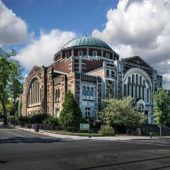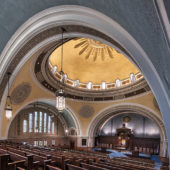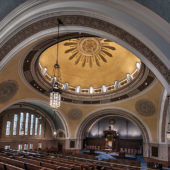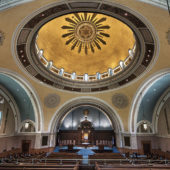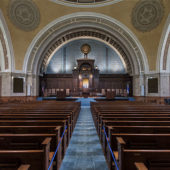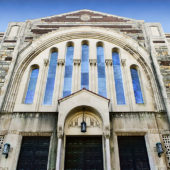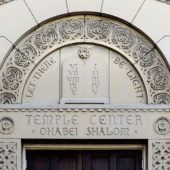The oldest Jewish congregation in Massachusetts and fourth oldest in New England
Content paraphrased and condensed from Wikipedia and the American Jewish Historical Society notes.
Temple Ohabei Shalom (Lovers of Peace) is the oldest Jewish congregation in Massachusetts and fourth oldest in New England. It was founded on February 26, 1843 by the families of Isaac Wolf, Peter Spitz, William Goldsmith, Bernard Fox, Charles Heineman, Jacob Norton, Abraham F. Block, Moses Ehrlich, Bernard Wurmsur, and Julius Spitz. Initially services were held in the Spitz home. .
For the next nine years congregants met in a private homes. In 1852, the synagogue dedicated its building on Warrenton Street in Boston. Instruction in both German and Hebrew was taught in the school adjacent to the Synagogue. There were factions within the congregation that eventually created a division between the Polish and German Jewish congregants. Polish Jews were unhappy with the Bavarian rituals and the German cantor, Joseph Sachs.
Breaking away from the congregation, the German Jews took with them Sachs as well as the Ohabei Shalom name and rights to the cemetery, building, and bequest monies of Judah Touro. The disagreement was brought to the civil court, which ruled in favor of the Polish Jews, and the temple formally separated into two congregations. Ohabei Shalom, the Polish synagogue, maintained the cemetery in East Boston, the bequest money, and the name. In 1855, the German Jews moved to a building on Pleasant Street, purchased cemetery land in Wakefield, Massachusetts, and named their synagogue “Adath Israel”-now Temple Israel in Boston. In 1858, Jews from East Prussia broke away and formed yet another congregation-Die Israelitische Gemeinde Mishkan Israel (now Mishkan Tefila in Chestnut Hill, Massachusetts.) The discord between Adath Israel and Ohabei Shalom did not last however, and in 1864 men from both congregations established the United Hebrew Benevolent Association (a forerunner of the Combined Jewish Philanthropies of Boston.)
In 1863, the synagogue moved across the street from its original building, followed by a move in 1887 to Union Park Street in the South End. In 1921, the synagogue purchased land in Brookline, Massachusetts, where the synagogue still stands. In the 1870s, the congregation began to adopt changes to their rituals in order to maintain relevancy in the changing Boston Jewish community. In 1870, the congregation held its first confirmation for boys and girls. This was followed by the establishment of a mixed choir in 1871. In 1875, family pews were installed and women were no longer required to sit in the gallery.
The congregation’s present building, an opulent structure in suburban Brookline that combined Byzantine Revival and Moorish Revival styles, was dedicated in 1925. The sanctuary seats 1,750. The smaller chapel accommodates 300. The domed building was intended to have a tall minaret, architectural drawings of the building with the minaret survive, although it was never built. The sanctuary was modeled on Hagia Sophia because of the excitement then felt over the then recent excavations of Byzantine-era synagogues in the land of Israel. The building includes a large school, an auditorium, a ballroom (that can be used as a gymnasium,) a museum, a library, and a reading room.

